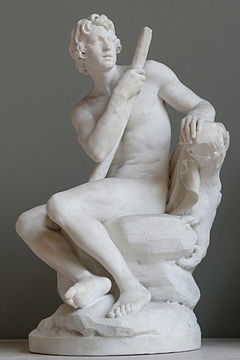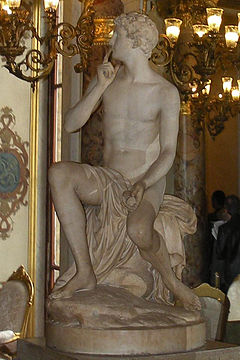Louis-Philippe Mouchy
Louis-Philippe Mouchy | |
|---|---|
| Born | 31 March 1734 Paris, France |
| Died | 10 December 1801 (aged 67) Paris, France |
| Nationality | French |
| Occupation | Sculptor |
Louis-Philippe Mouchy (31 March 1734 – 10 December 1801) was a French sculptor.
Early years
Louis-Philippe Mouchy was born in 1734. He was a student of Jean-Baptiste Pigalle, and married Pigalle's niece.[1] Mouchy followed Pigalle's style closely throughout his career.[2] He was given provisional membership of the Académie royale de peinture et de sculpture on 27 September 1766 and was admitted as a full academician on 25 June 1768.[1] His reception piece was Un Berger qui se repose (Shepherd at Rest).[2] Diderot described this work as "a rather literal copy of the first figure one sees to the left when entering the
Academician
Mouchy made a statue of Cupid Carving his Darts from the Club of Hercules from an original by Edmé Bouchardon. The copy was installed in a small round Temple of Love built for Marie Antoinette by Richard Mique in the garden of the Petit Trianon.[3] Mouchy collaborated with
Mouchy was made an assistant professor at the Académie royale, which gave him precedence when the
Mouchy's son-in-law was the painter and engraver Philibert-Louis Debucourt. In the marriage contract Mouchy generously offered to provide a three-room apartment at the Louvre, where Debucourt lived for twelve and a half years.[7] Mouchy died in 1801.[2]
-
Statue of Mary by Pigalle at Saint-Sulpice. The stucco decoration is by Mouchy
-
Seated shepherd, Mouchy's reception piece for the Academy
-
Cupid Carving his Darts from the Club of Hercules
-
Harpocrates, god of silence
References
Citations
- ^ a b c Goodman 1995, p. 312.
- ^ a b c d e Levey 1993, p. 250.
- ^ D'Hoste 2008, p. 124.
- ^ Scherf 2005, p. 18.
- ^ Gordon 2003, p. 94.
- ^ Bailey 2002, p. 81-82.
- ^ Taws 2013, p. 181.
Sources
- Bailey, Colin B. (2002). Patriotic Taste: Collecting Modern Art in Pre-revolutionary Paris. Yale University Press. ISBN 978-0-300-08986-8. Retrieved 2014-07-01.
- D'Hoste, J. Georges (2008). Tutta Versailles. Ediz. Inglese. Casa Editrice Bonechi. ISBN 978-88-476-2294-4. Retrieved 2014-07-01.
- Goodman, John (1995). Diderot on Art: The salon of 1767. Yale University Press. ISBN 978-0-300-06252-6. Retrieved 2014-07-01.
- Gordon, Alden R. (2003). The Houses and Collections of the Marquis de Marigny. Getty Publications. ISBN 978-0-89236-694-1. Retrieved 2014-07-01.
- Levey, Michael (1993). Painting and Sculpture in France, 1700–1789. Yale University Press. ISBN 978-0-300-06494-0. Retrieved 2014-07-01.
- Scherf, Guilhem (2005-06-01). "Houdon, "Above all Modern Artists"". Jean-Antoine Houdon: Sculptor of the Enlightenment. University of Chicago Press. ISBN 978-0-226-67649-4. Retrieved 2014-07-01.
- Taws, Richard (2013). The Politics of the Provisional: Art and Ephemera in Revolutionary France. Penn State Press. ISBN 978-0-271-06189-4. Retrieved 2014-07-01.
External links
- Louis-Philippe Mouchy in American public collections, on the French Sculpture Census website




